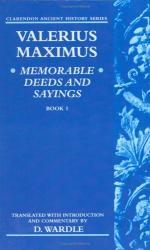|
This section contains 12,033 words (approx. 41 pages at 300 words per page) |

|
SOURCE: Carter, C. J. “Valerius Maximus.” In Empire and Aftermath, Silver Latin II, edited by T. A. Dorey, pp. 26-56. London: Routledge & Kegan Paul, 1975.
In the following essay, Carter surveys the content, structure, style, sources, influence, textual history, and reception of Valerius's Memorable Doings and Sayings, commenting primarily on the work's stylistic limitations and the reasons for its centuries-long popularity.
The great German nineteenth-century historian, Niebuhr, was perhaps exaggerating when he said that the Middle Ages considered Valerius Maximus ‘the most important book next to the Bible’1 but he was certainly well-known and much read by all who counted themselves educated from the time of Charlemagne to the sixteenth century, and when, for example, the foundation statutes of Corpus Christi College, Oxford, were drawn up in 1517, Valerius was one of the four prose authors prescribed for daily lectures to first-year students.2 Yet a Classics student at University today...
|
This section contains 12,033 words (approx. 41 pages at 300 words per page) |

|


